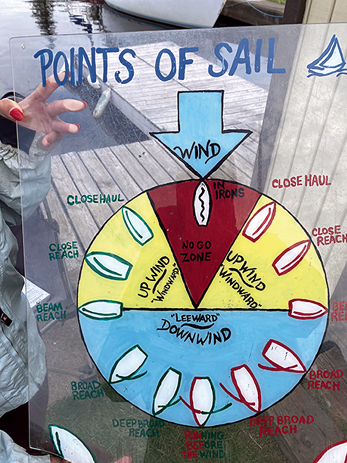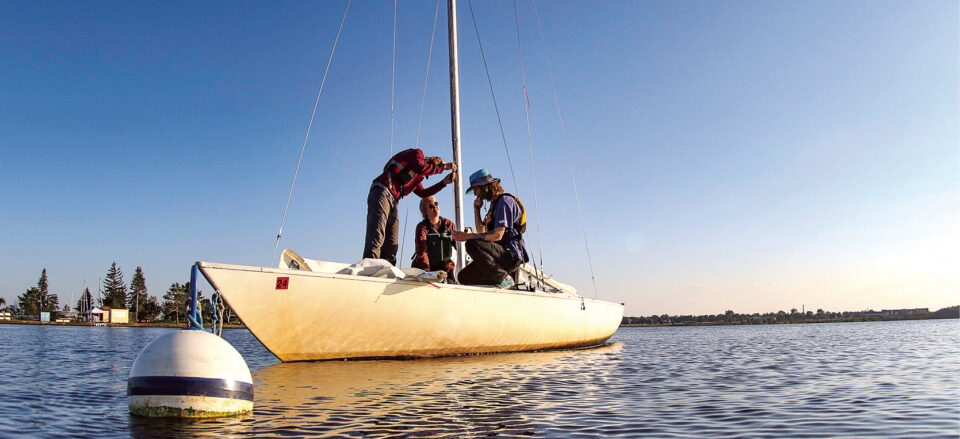It was a moment of temptation, terror, and trust: I was taking my unsuspecting mom and three children out in a 19-foot sailboat in 15 knot west winds on the Duluth-Superior Harbor. My previous sailing experience? A couple lessons with an instructor, and a few family sails on calm nights, with my savvy wife doing most of the sail trimming.
Whitecaps were frothing alongside the Duluth-Superior Sailing Association (DSSA) pier at the end of Park Point on this August afternoon. Either we were going to swamp in seconds, or make a miracle run: no matter what, we were going to gain the REAL sailing experience I so craved.
DSSA Waterfront Director Zach Lange looked me in the eye as we loaded into the O-Day Mariner (“a relatively stable and easy-to-handle” boat, according to the DSSA website), and asked if I was truly ready for the challenge ahead. “Of course,” I lied through my teeth, secretly hoping my two daughters, who had done the DSSA’s week-long Novice Sailing Camp earlier that summer, would miraculously get us out of trouble.
With the fierce wind blasting down the Duluth hillside, sweeping the length of the harbor, and smashing into the pier, the biggest challenge would come right off the bat—launching from the pier’s lee side, then doing a 270 degree turn around the pier and into an upwind position.
Prayers wouldn’t cut it—we were going to learn to sail or die trying.
Lange pushed us off, my first-mate Vanessa and I started pulling the sheets (ropes), and at that moment our whole family went hurtling right towards the cement pier at warp speed. To this day, I don’t know how we managed, but Vanessa got the boat to make a last-second 90 degree turn when we were inches from striking the pier, and we proceeded to get the Mariner into an upwind, controllable position.
After the initial shock, tears still wet on our faces, we proceeded to make an incredible upwind run (something I never thought was possible in a sailboat, until we were doing it), straight towards Duluth. Vanessa and I got into a groove handling the sails. It was an awesome feeling—harnessing the fearsome winds to our own advantage. We turned around 30 minutes later, and flew back to the pier, just as the waves were getting even higher.

The final test—docking the boat—went exceedingly well. Lange complimented us on our wonder ride, without a single collision of any kind. We jumped on the dock, ready to kiss solid ground. Never had sailing (or practically anything else in my life) felt so invigorating and encaptivating.
Continuous Development
The DSSA is a community sailing program that provides these kinds of formative experiences to everyone. Indeed, the DSSA’s mission is “to offer the joy of sailing to the entire Duluth-Superior community, regardless of skill level, physical capabilities, or financial means.”
Jim Sharrow, president of the DSSA’s board of directors for 22 years running, encapsulates this philosophy. “My commitment is to make the sport of sailing available to the general public through mentoring and inexpensive access,” explains Sharrow, only the second president of the board in the DSSA’s 29-year-existence as a 501(c)(3) non-profit organization.
He was proceeded as president by Scott R. Anderson, a sailor paralyzed from mid-chest down from the age of 16. Anderson took part in the DSSA’s adaptive sailing program, and was a DSSA member who sailed just like any other member.
When Sharrow came on as DSSA board president, the City of Duluth had just stopped funding the organization in 2001. The DSSA had only one staff member, and an annual budget of $3,500.
Today the DSSA has grown in multiple directions. “We have 10 certified staff, not just one. We run a program seven days a week. We teach adults. We have all-day long summer camps for kids at market rates. We also seek ways to let anyone take part in our program. We don’t turn anybody away,” recounts Sharrow.
Sharrow is particularly proud of the DSSA’s community role during COVID. “We got handless walkie-talkies for our staff, and a louder bullhorn, and all the kids at sailing camp were able to use solo boats. We were one of the only summer camps open during COVID, and we were completely full.”

Today, DSSA members (a family membership costs $200 per year) can take an array of classes to start their sailing journey. More advanced sailors can take the American Sailing Association levels 101, 103, and 104 classes with DSSA instructors. Other options include open sailing, youth camps, and private lessons. The DSSA also partners with Northland Adaptive Recreation to provide sailing experiences and lessons for sailors with physical limitations. This well-rounded program has something for everyone.
Prized Staff
Zach Lange became a DSSA employee while still a student at UMD in 2017, and is now in his sixth year as DSSA’s waterfront director. Lange says the DSSA is “just like Duluth—it has a homey, Midwest vibe.” Lange invites everyone down to Park Point: “Our mission is sailing for all in Duluth and Superior, but we’re open to everybody—outsiders too.”
Lange not only manages boats and sailing lessons, but also the DSSA’s staff. “I’ve been so lucky to find instructors from different family backgrounds that grew up in the DSSA, and are now instructors,” recounts Lange.
Remembering my crazy day on the harbor with my family last August, Lange said his team is equipped to handle whatever comes their way. “Our staff have the skill levels, and the tools, to manage a crazy day. So somebody like you can take your family out, even though you’re a little on edge, and feel safe.”
Another long-term DSSA staff member is Pawel Waszczuk, who learned to sail in Poland. “My parents are both sailors, and from a very young age they started signing me up for sailing camps in Poland, very similar to the sailing association here. Then, when I got old enough, I started doing sleep-away camps on sailboats, and learning navigation,” explains Waszczuk.

Earning his first instructor certification at age 16, today Waszczuk is qualified to teach ASA classes. “Here at DSSA, we’re backed by the American Sailing Association, and what we teach at camp or during private lessons is the safest way to sail. There’s a lot of different ways to do things on a sailboat. We really try to teach people the safest way first.”
In his free time, Waszczuk is usually out riding a surfboard. He sees endless parallels between surfing and sailing. “Surfing and sailing go hand in hand. They complement each other incredibly well. Both sports require a lot of knowledge about the environment, about the water we’re swimming in, and sailing in, and about weather conditions.”
Waszczuk also notes the “limitless, floating experience” obtained in both sports. Waszczuk finds that being a surfer has made him a better sailor. “Just being more comfortable in the water. As a surfer, I’m comfortable being submersed in the water at all times. It’s not rare for sailors to not be comfortable being in the water.”
All of the DSSA’s staff (and students) will likely agree with Waszczuk that the ultimate purpose of sailing is “serenity.” Waszczuk describes this serenity as “feeling like I’m a part of something greater. Really being submersed in the elements. That is something that just allows my brain to become silent, to really pay attention to the moment, what’s going on right now. To me, that’s what life’s about.”
Dream Boats
Buying a boat is the cheapest and easiest part of owning a sailboat. It’s the storage, maintenance, and repairs that are an incredible amount of work, and oftentimes a lot of money as well.
Enter the DSSA—your ultimate “turnkey” sailing solution. The DSSA owns a diverse fleet of trainers, racers, day-sailers, and cruisers that it maintains and stores on the money paid by members for their annual memberships.

There’s a boat for everyone at the DSSA. Youngsters learn on Optimist Prams, 2.4 Meters, and Olympic Class Lasers. Families can take out the O’Day Day Sailer, Interlake 19, O’Day Mariner 19, Flying Scot, and Yngling 21. Finally, the DSSA’s Catalina 22, Soling 27, Cal T/4, and Catalina 25 can all be taken on the open waters of Lake Superior by members certified to use them.
Most of the DSSA’s boats have been donated over the years. Lange describes these donations as “incredibly fortunate” for the DSSA. “It’s super special. I don’t even know where we would be if we didn’t have so many of these boats donated. We’ve been able to put so many people on the water and teach so many people with these boats.”
And when winter comes? As a member, you won’t need to figure out how to wrap and store a 25-foot boat, or pay for all the maintenance that a season of use incurs. Being a DSSA member is like having your own boat, without all the hassle.
Idyllic Location
The DSSA’s idyllic location adds to its unique vibe. The Duluth-Superior Harbor is the world’s largest freshwater port, and the DSSA has a unique spot on it. Its waterfront operations take place on a small point that projects into the harbor just off Minnesota Avenue, on Park Point’s eastern end. There is a DNR public boat launch at the same location, as well as canoe and kayak storage offered by the City of Duluth.
“We’re in such a special spot down there, on Park Point,” says Lange. “It’s a perfect combination of having a controlled environment, for the most part, in the harbor, to get your skills down, and then we can transfer you to the lake, and teach you all the ins and outs to get onto Lake Superior.”
Lange notes that ships come from around the world right past the DSSA pier. Another Park Point neighbor is the Sky Harbor Airport, where small planes regularly take off and land. All this surrounding transportation revs up the energy level at the DSSA waterfront.

Waszczuk also notes the harbor’s contrasts. “On one side of the harbor is Park Point, which is strictly residential and recreational land. Then on the other side there’s a lot of industry going on. So it’s a very interesting and dynamic space, which is not something that sailors can experience on inland lakes.”
Ultimately, the DSSA’s protected location is key to its programming. “We’re protected from the amazing power of Lake Superior, so we can teach novice sailors,” explains Waszczuk. “At the same time, when people progress to a point where they can manage themselves, and they have the experience to be safe out on the big lake, it’s very easy to get out to Lake Superior.”
Come See For Yourself
The DSSA will be hosting its annual Open House on June 8 this year from noon to 6 p.m. The event always takes place the weekend after Duluth schools go on summer break, and is meant to introduce families to sailing.
“We want to promote the program and give free sailing rides,” says Lange. “You can come down and talk to me, talk to board members and other staff, and we’ll take you out for a cruise. It’s like an intro to sailing. We’ll teach you a few things, and let you get on the tiller.”
Open House is for members and non-members alike, so come see what incredible sailing opportunities await you. Everyone is welcome. Find more info online at: sailingforall.org.




